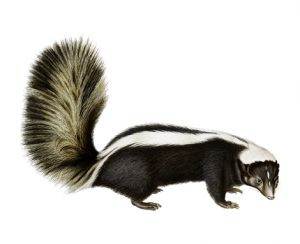Skunks are mammals best known for their ability to secrete a liquid with a strong, foul odour. Skunks belong to the family Mephitidae and to the order of Carnivora. There are 10 species of skunks, which are divided into four genera: Mephitis (booded and striped skunks, two species), Spilogale (spotted skunks, two species), Mydaus (stink badgers, two species), and Conepatus (hog-nosed skunks, four species). The stwo skunk species in the Mydaus genus inhabit Indonesia and the Philippines; all other skunks inhabit North and South America.
They are omnivorous, eating both animal and plant material, with insect larvae forming a large part of their diet. They have become accustomed to humans, thriving in semi-open agricultural areas, mixed woods, meadows, and even urban areas. In the fall is when they feed voraciously, building up fat reserves for winter dormancy. With the onset of cold weather, they seek out dens, and hibernate for the winter. Areas that provide dark secure hiding places are commonly used as den sites, like under barns, utility sheds, and porches.
Mating occurs in late February and early March when males become active, leaving their dens in search of females. Female skunks will usually produce 5 kits on average, with the young being born in late April or may after a gestation period of 62 days. Within a month, females and young can be seen actively foraging for food.
Traps to catch skunks are often set up at entrances of known denning sites, or around their feeding areas. A wooden box trap with a wire mesh end is an ideal way to control the skunks. When caught in box traps, they can be safely moved if caution is taken to avoid shaking the trap. Wire mesh traps must be carefully covered with a cloth material before moving it.




